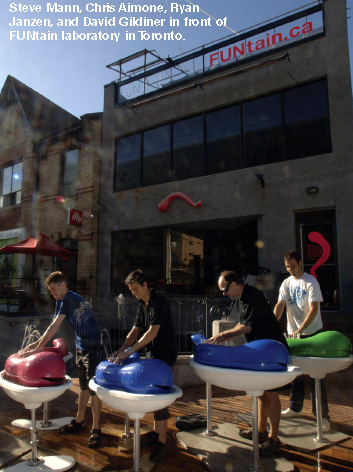|

Sophisticated Fun
FUNtain introduces a groundbreaking, original instrument to the
attractions market—a flute/piano combination you can play in your
bathing suit
by Marion Hixon
 STEVE
MANN SPENT THE PAST 25 YEARS fulfilling a childhood dream: creating an
instrument that plays music with water. The Hydraulophone is
essentially a pipe organ with water running throughout and shooting
from its holes. It works like a flute and is played like a piano. With
anywhere between 12 and 45 notes (patented “Hydraulikeys”), the long
cylindrical tube is simplistically refined in appearance, but
masterfully engineered inside. STEVE
MANN SPENT THE PAST 25 YEARS fulfilling a childhood dream: creating an
instrument that plays music with water. The Hydraulophone is
essentially a pipe organ with water running throughout and shooting
from its holes. It works like a flute and is played like a piano. With
anywhere between 12 and 45 notes (patented “Hydraulikeys”), the long
cylindrical tube is simplistically refined in appearance, but
masterfully engineered inside.
Inspired by Water
“The basic idea of the Hydraulophone is that when you obstruct or
change the flow of water with your finger, it causes some other type of
multimedia event to occur,” Mann says. He and Chris Aimone, designer
and head engineer at FUNtain (FUNtain.ca), were both inspired by the
states of matter and the idea to introduce liquid to the world of
music. “After seeing the orchestra only has two sections—strings and
percussion—I thought, ‘Why are there no instruments that make sounds
from liquid,’” Mann says.
Mann started teaching engineering at the University of Toronto in 1998
and along the way began collaborating with Aimone, his one-time
student. Together, the two perfected multiple versions of the
instrument, starting with Mann’s early “H2Organ,” on which he’s
performed live. He filed a patent for the invention and over time began
marketing it as an attraction.
FUNtain formed in 2006, and Mann and Aimone added David Gildiner as
director of sales and marketing, and Ryan Janzen, who holds the rare
title of hydraulist/composer. Mann and his cohorts seem to have entered
the attractions industry through the back door—not realizing until
recently their high-quality musical instrument may be popular at
facilities like theme parks, museums, zoos, and waterparks.
From Business Suit to Bathing Suit
“It’s funny that the older versions of the instrument had water
spraying everywhere, and that’s now what the attractions industry
wants,” says Mann. “You can’t walk into a concert hall and spray water
on violinists.”
The FUNtain team believes the instrument is a kid magnet due to its
approachable design (the “Nessie” line is a worm-shaped Hydraulophone
version for kids) and the fact that participants needn’t be musicians
to play successfully. “A day at the amusement park can double as a
music lesson,” Mann says.
Gildiner says the attraction lures both kids and adults to participate.
“Every other water feature gets people wet while parents sit under an
umbrella reading the paper,” he says. “Once kids understand they’re
making music, cover up two holes, and play this beautiful chord,
parents get a little more interested and play themselves. They block
the holes and think, ‘Whoa, I just played a C-Minor!’”
Those C-Minors can be heard in facilities from the Ontario Science
Center in Canada to Baylor University’s Mayborn Museum Complex in Waco,
Texas. Hydraulophone installations are both mobile and stationary;
suitable for indoors and outside; and operate on high flow (for getting
wet) and low flow (for staying dry). They range in style from the
Nessie line to large sculptural pieces.
The Ontario Science Center boasts a permanent outdoor Hydraulophone as
the focal piece of its circular front walkway, open 24 hours a day to
the public. “It speaks artistically because they wanted a grand,
majestic civic sculpture,” Mann says. “But it’s also a fun park with a
splash area, which challenges the preconceived distinction between work
and play. We call it ‘sophisticated frolic.’”
Contact Departments Editor Marion Hixon at mhixon@IAAPA.org.
|

